
Everyone who was involved in the Vietnam War, referred to the enemy as the VC or Viet Cong and the NVA, North Vietnamese Army. These two titles helped to distinguish the difference between the regular army of the North and the gurella units which operated in South Vietnam. They both reported to the same command structure. BUT, historically, the true name of the army in the North was the VPA or Vietnam People's Army which was formed around 1948 and which fought successfully against the French (1946-1954), also known as the Viet Minh. Today (2013) the army is still referred to as the VPA and the People's Army of Vietnam.
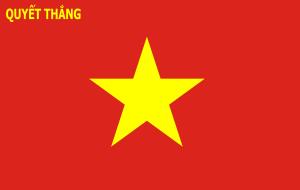
2013 - Present - Flag of Vietnam People's Army - "Determined to Win" - Slogan

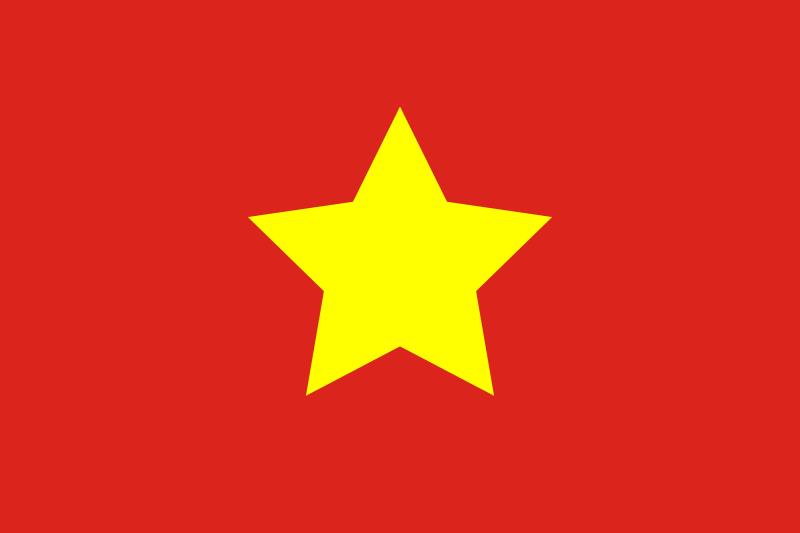
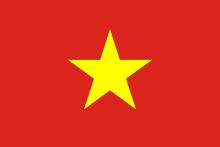
1945-1955 - Flag of the Viet Minh state in Northern Vietnam. Adopted by the Viet Minh in 1941.
1955-Present - National Flag of North Vietnam and the Socialist Republic of Vietnam
1968-1976 - Flag of the Provisional Revolutionary Government of the Republic of South Vietnam
When the French lost control of Vietnam (French Indochina) with the invasion of the Japanese Army and then their defeat at Dien Ben Phu in 1955, there were a number of flags which flew over the southern portion of Vietnam. As you can see, clearly, as early as 1945, there was a definate divide between North and South Vietnam and a power struggle for control over this region between two fractions, each seeking a different way of life and government.






1887-1923 Flag of French Colonial Empire
1923-1945 Protectorate flag of French Indochina
March 1945 - Flag of the Empire of Japan
1945 - Flag of the Empire of Vietnam (Japanese puppet state)
1945 - Flag of the Empire of Vietnam
1890-1920 - Flag used by Emperors - 1948-1975 - Flag of the Provisional Central Government of Vietnam and the State of Vietnam and South Vietnam (1955-75

1955-1975 Flag of the Army of the Republic of Vietnam
Flags of North Vietnam 1945 to Present
Flags of French Indochina, Empire of Vietnam and the RVN

VC Local Guerrillas
These were the 'farmers by day, soldiers by night', comprising those either too old or too young to fight in the regular VC units and dressed as local peasant farmers.
Whilst their primary activities consisted of intelligence gathering, sniping and emplacing booby traps, these troops were employed in the support of VC Regional and Main Force units operating in their locality as porters, scouts and guides.
Force size was dependent on the size of the local village or hamlet and ranged from a single 3 man cell to a platoon of 3-4 squads. Generally operated at the squad level of 12 men.
These were the 'farmers by day, soldiers by night', comprising those either too old or too young to fight in the regular VC units and dressed as local peasant farmers.
Whilst their primary activities consisted of intelligence gathering, sniping and emplacing booby traps, these troops were employed in the support of VC Regional and Main Force units operating in their locality as porters, scouts and guides.
Force size was dependent on the size of the local village or hamlet and ranged from a single 3 man cell to a platoon of 3-4 squads. Generally operated at the squad level of 12 men.
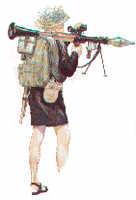
VC Regional Guerrillas
The Regional units of the Vietcong more often than not operated as independent companies but often split up and dispersed into platoons, squads and cells. These soldiers were full-timers and were better equipped and trained than the local guerrillas. The personnel of these units were often local to the area in which they served.
The Regional units of the Vietcong more often than not operated as independent companies but often split up and dispersed into platoons, squads and cells. These soldiers were full-timers and were better equipped and trained than the local guerrillas. The personnel of these units were often local to the area in which they served.

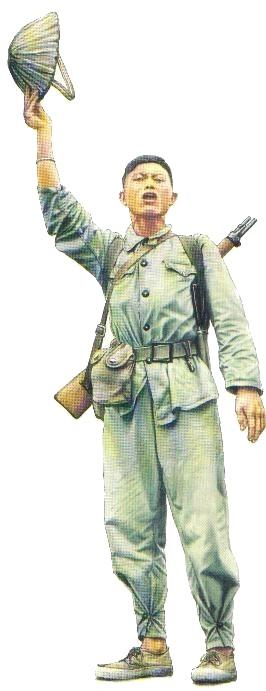
NVA BATTALION: Battalion HQ, Political Staff, 3 x Rifle Company, 1 x Combat Support Company, 1 x Signal Platoon, 1 x Recon Platoon, 1 x Sapper Platoon. As in other armies, battalions were organized into Brigades, Regiments and Divisions. The nature of the war however, with overwhelming US Artillery and Air power, precluded the fielding of large formations for any period of time longer than was necessary to carry out a particular mission. As a result units were dispersed quite widely, either in the sanctuaries of Laos and Cambodia or in Base Camps in very remote areas.
ORGANIZING A VIET CONG INFANTRY COMPANY
COMPOSITION OF COMPANY
1 x Company HQ Section
3 x Rifle Platoons (each 1 x Platoon HQ Section, 4 x Rifle Squad)
Combat Support Elements (Attached)
Company HQ Section
1 x Captain
1 x Lieutenant
1 x RTO
2 x Runner
Rifle Platoon HQ Section
1 x Lieutenant
1 x Senior Sergeant
1 x Runner
Rifle Squad
1 x Sergeant
1 x Corporal
1 x RPD 7.62mm MG
6 x Riflemen
Combat Support
1 x Sergeant
2 x Corporal
1 x .30 Cal MG (3 crew)
1 x 60mm Mortar (3 crew)
1 x 57mm RR (3 crew)
3 x Riflemen
COMPOSITION OF COMPANY
1 x Company HQ Section
3 x Rifle Platoons (each 1 x Platoon HQ Section, 4 x Rifle Squad)
Combat Support Elements (Attached)
Company HQ Section
1 x Captain
1 x Lieutenant
1 x RTO
2 x Runner
Rifle Platoon HQ Section
1 x Lieutenant
1 x Senior Sergeant
1 x Runner
Rifle Squad
1 x Sergeant
1 x Corporal
1 x RPD 7.62mm MG
6 x Riflemen
Combat Support
1 x Sergeant
2 x Corporal
1 x .30 Cal MG (3 crew)
1 x 60mm Mortar (3 crew)
1 x 57mm RR (3 crew)
3 x Riflemen
The attached Combat Support Elements of the Company are not fixed, unlike the Weapons squads of the US Rifle Platoon and are very versatile. All VC operations were carefully planned and executed and invariably involved considerable supporting fire for the Rifle Company's involved. Main Force units would often be supported by Weapons Platoons consisting of heavier weapons such as 12.7mm AAMG's, 81/82mm Mortars and larger calibre Recoilless Rifles (normally 75mm).
NVA Main-force Regulars
Known as 'hard hats' since they wore the ubiquitous pith helmet, these forces operated and were organised along traditional military lines. Organised into battalions consisting of 3 Rifle Company's and a Combat Support Company these troops were, on the whole, well trained, aggressive and well led.
On larger operations they could be organised and deployed as regiments of 2-3 battalions.
Known as 'hard hats' since they wore the ubiquitous pith helmet, these forces operated and were organised along traditional military lines. Organised into battalions consisting of 3 Rifle Company's and a Combat Support Company these troops were, on the whole, well trained, aggressive and well led.
On larger operations they could be organised and deployed as regiments of 2-3 battalions.
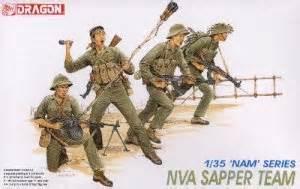
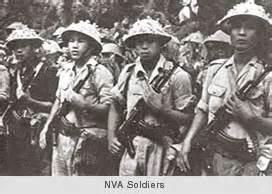

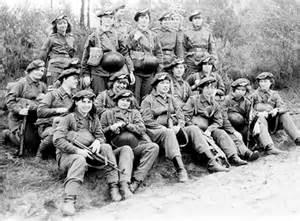


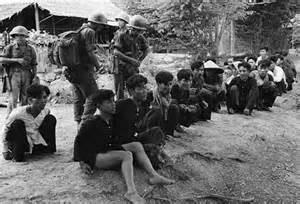


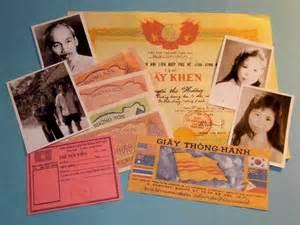
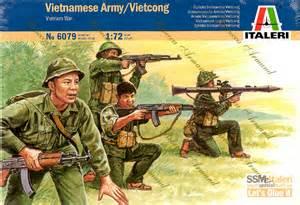
NLF - National Liberation Front (later merged and became the PRG, Peoples Revolutionary Government)
The political arm of the Communist Party and propaganda machine for it's war effort to overthrown the South Vietnamese government and it's military counterpart, the Viet Cong. North Vietnam established the National Liberation Front in 1960 to ferment insurgency in the South. Many of the Viet Cong's core members were "regroupees", southern Viet Minh who had resettled in the North after the Geneva Accord (1954). Hanoi gave the regroupees military training and sent them back to the South along the Ho Chi Minh trail in the early 1960s. The NLF called for southern Vietnamese to "overthrow the camouflaged colonial regime of the American imperialists" and to make "efforts toward the peaceful unification." The Viet Cong's best-known action was the Tet Offensive, a massive assault on more than 100 South Vietnamese urban centers in 1968, including an attack on the US embassy in Saigon. The offensive riveted the attention of the world's media for weeks, but also over extended the Viet Cong. Later communist offensives were conducted predominately by the North Vietnamese. The organization was dissolved in 1976 when North and South Vietnam were officially unified under a communist government.
"Many Viet Cong units operated at night, and employed terror as a standard tactic. Rice procured at gunpoint sustained the Viet Cong. Squads were assigned monthly assassination quotas. Government employees, especially village and district heads, were the most common targets. But there were a wide variety of targets, including clinics and medical personnel. Notable Viet Cong atrocities include the massacre of over 3,000 unarmed civilians at Hu?, 48 killed in the bombing of My Canh floating restaurant in Saigon in June 1965 and a massacre of 252 Montagnards in the village of Ð?k Son in December 1967 using flamethrowers. Viet Cong death squads assassinated at least 37,000 civilians in South Vietnam; the real figure was far higher since the data mostly cover 1967-72. They also waged a mass murder campaign against civilian hamlets and refugee camps; in the peak war years, nearly a third of all civilian deaths were the result of Viet Cong atrocities. Ami Pedahzur has written that "the overall volume and lethality of Viet Cong terrorism rivals or exceeds all but a handful of terrorist campaigns waged over the last third of the twentieth century".(Source - Wikipedia - 2013)
The PAVN (People's Army of Vietnam) ran their military operations through COSVN (central Office of South Vietnam) which was located in Tay Ninh Province, a military structure that S2 (intelligence) spent much time and effort trying to locate and destroy. We were unsuccessful in ever finding this operation. COSVN was responsible for directing the NLF/Viet Cong military and psychological operations in the south.
The Tet Offensive was the planning and work of the Viet Cong. Estimates by the North (PAVN, 75,000 KIA"D) and the U.S. Joint Chiefs of Staff (PAVN, 40,000 KIA'D) vs 10,600 U.S. And South Vietnamese dead explains the "lull on the battlefield from March 68 to September 68. The North's forces were decimated by this offensive and they were unable to replace their losses with new recruits according to the PRG (People's Revolutionary Government) which replaced the NLF in June, 1969.
The political arm of the Communist Party and propaganda machine for it's war effort to overthrown the South Vietnamese government and it's military counterpart, the Viet Cong. North Vietnam established the National Liberation Front in 1960 to ferment insurgency in the South. Many of the Viet Cong's core members were "regroupees", southern Viet Minh who had resettled in the North after the Geneva Accord (1954). Hanoi gave the regroupees military training and sent them back to the South along the Ho Chi Minh trail in the early 1960s. The NLF called for southern Vietnamese to "overthrow the camouflaged colonial regime of the American imperialists" and to make "efforts toward the peaceful unification." The Viet Cong's best-known action was the Tet Offensive, a massive assault on more than 100 South Vietnamese urban centers in 1968, including an attack on the US embassy in Saigon. The offensive riveted the attention of the world's media for weeks, but also over extended the Viet Cong. Later communist offensives were conducted predominately by the North Vietnamese. The organization was dissolved in 1976 when North and South Vietnam were officially unified under a communist government.
"Many Viet Cong units operated at night, and employed terror as a standard tactic. Rice procured at gunpoint sustained the Viet Cong. Squads were assigned monthly assassination quotas. Government employees, especially village and district heads, were the most common targets. But there were a wide variety of targets, including clinics and medical personnel. Notable Viet Cong atrocities include the massacre of over 3,000 unarmed civilians at Hu?, 48 killed in the bombing of My Canh floating restaurant in Saigon in June 1965 and a massacre of 252 Montagnards in the village of Ð?k Son in December 1967 using flamethrowers. Viet Cong death squads assassinated at least 37,000 civilians in South Vietnam; the real figure was far higher since the data mostly cover 1967-72. They also waged a mass murder campaign against civilian hamlets and refugee camps; in the peak war years, nearly a third of all civilian deaths were the result of Viet Cong atrocities. Ami Pedahzur has written that "the overall volume and lethality of Viet Cong terrorism rivals or exceeds all but a handful of terrorist campaigns waged over the last third of the twentieth century".(Source - Wikipedia - 2013)
The PAVN (People's Army of Vietnam) ran their military operations through COSVN (central Office of South Vietnam) which was located in Tay Ninh Province, a military structure that S2 (intelligence) spent much time and effort trying to locate and destroy. We were unsuccessful in ever finding this operation. COSVN was responsible for directing the NLF/Viet Cong military and psychological operations in the south.
The Tet Offensive was the planning and work of the Viet Cong. Estimates by the North (PAVN, 75,000 KIA"D) and the U.S. Joint Chiefs of Staff (PAVN, 40,000 KIA'D) vs 10,600 U.S. And South Vietnamese dead explains the "lull on the battlefield from March 68 to September 68. The North's forces were decimated by this offensive and they were unable to replace their losses with new recruits according to the PRG (People's Revolutionary Government) which replaced the NLF in June, 1969.

War Losses for the North:
Civilian deaths in the war: North losses are estimated at 50-65,000 but is was difficult to distinguish between civilians and military personnel.
North Vietnamese Army (PAVN) and Viet Cong Losses are estimated at 1,100,000
The government of Vietnam only recently acknowledged the extent of their losses during this war.
War Losses for the South:
Civilian deaths in the war: South estimated at 195,000-430,000
ARVN is estimated between 171,000 and 220,000 and as high as 313,000
Civilian losses after the war ended (1975 and beyond)
Up to 155,000 refugees fleeing the final NVA Spring Offensive were killed or abducted on the road to Tuy Hoa in 1975. Sources have estimated that 165,000 South Vietnamese died in the re-education camps out of 1-2.5 million sent, while the number executed could have been as high as 200,000. Jacqueline Desbarats estimates an absolute minimum of 100,000 executions. Rummel estimates that slave labor in the "New Economic Zones" caused 50,000 deaths (out of a total 1 million deported). The number of Vietnamese boat people who died is estimated between 200,000 and 400,000, out of the 2.5 million that fled.There were also tens of thousands of suicides after the North Vietnamese take-over. Including Vietnam's foreign democide, Rummel estimates that a minimum of 400,000 and a maximum of slightly less than 2.5 million people died of political violence from 1975-87 at the hands of Hanoi.[65] In 1988, Vietnam suffered a famine that afflicted millions.[68]
Under the leadership of Pol Pot, the Khmer Rouge killed 1-3 million Cambodians in the killing fields, out of a population of around 8 million. The Pathet Lao killed some 100,000 Hmong people in Laos. (source - Wikipedia, 2013)
Civilian deaths in the war: North losses are estimated at 50-65,000 but is was difficult to distinguish between civilians and military personnel.
North Vietnamese Army (PAVN) and Viet Cong Losses are estimated at 1,100,000
The government of Vietnam only recently acknowledged the extent of their losses during this war.
War Losses for the South:
Civilian deaths in the war: South estimated at 195,000-430,000
ARVN is estimated between 171,000 and 220,000 and as high as 313,000
Civilian losses after the war ended (1975 and beyond)
Up to 155,000 refugees fleeing the final NVA Spring Offensive were killed or abducted on the road to Tuy Hoa in 1975. Sources have estimated that 165,000 South Vietnamese died in the re-education camps out of 1-2.5 million sent, while the number executed could have been as high as 200,000. Jacqueline Desbarats estimates an absolute minimum of 100,000 executions. Rummel estimates that slave labor in the "New Economic Zones" caused 50,000 deaths (out of a total 1 million deported). The number of Vietnamese boat people who died is estimated between 200,000 and 400,000, out of the 2.5 million that fled.There were also tens of thousands of suicides after the North Vietnamese take-over. Including Vietnam's foreign democide, Rummel estimates that a minimum of 400,000 and a maximum of slightly less than 2.5 million people died of political violence from 1975-87 at the hands of Hanoi.[65] In 1988, Vietnam suffered a famine that afflicted millions.[68]
Under the leadership of Pol Pot, the Khmer Rouge killed 1-3 million Cambodians in the killing fields, out of a population of around 8 million. The Pathet Lao killed some 100,000 Hmong people in Laos. (source - Wikipedia, 2013)



